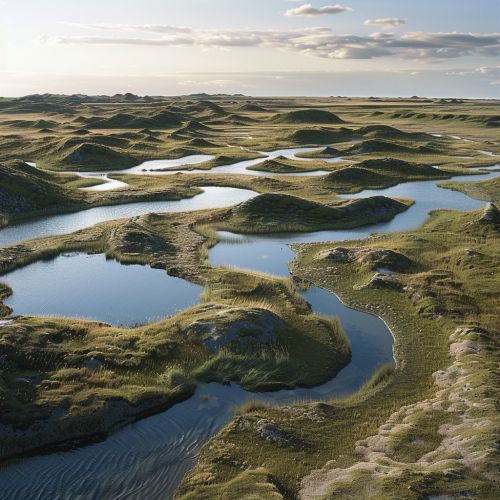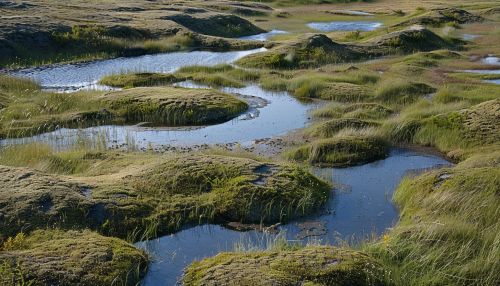Thermokarst
Introduction
Thermokarst is a type of periglacial landscape that results from the thawing of ground ice in a region underlain by permafrost. In these regions, the ice in the permafrost melts and causes the ground to collapse, forming irregular surfaces of marshy hollows and small hummocks. This process can be accelerated by climate change, leading to significant changes in the landscape and ecosystem of the affected area.


Formation and Characteristics
Thermokarst landscapes are formed through a process known as thaw subsidence. This occurs when the ice within the permafrost begins to thaw, causing the ground above to sink and form irregular surfaces. The term "thermokarst" is derived from the Russian words "thermo" (meaning heat) and "karst", a type of landscape formed from the dissolution of soluble rocks.
The formation of thermokarst landscapes can be influenced by several factors, including the climate, the type of permafrost, and the presence of vegetation. In regions with a cold climate, the permafrost is generally stable and thermokarst formation is less likely. However, in regions with a warmer climate, the permafrost can thaw more easily, leading to the formation of thermokarst landscapes.
The type of permafrost also plays a significant role in the formation of thermokarst landscapes. Permafrost that is rich in ice is more susceptible to thawing and can lead to more extensive thermokarst formation. On the other hand, permafrost that is poor in ice is less susceptible to thawing and thermokarst formation is less likely.
Vegetation can also influence the formation of thermokarst landscapes. In regions with dense vegetation, the plants can insulate the ground and slow down the thawing of the permafrost. However, in regions with sparse vegetation, the ground is more exposed to the sun and the permafrost can thaw more quickly, leading to the formation of thermokarst landscapes.
Impact on Ecosystems
Thermokarst landscapes can have significant impacts on the ecosystems of the affected areas. The formation of thermokarst can lead to changes in the hydrology of the region, affecting both the surface and groundwater systems. This can result in changes to the vegetation and wildlife in the area.
In addition, the formation of thermokarst can lead to the release of greenhouse gases, such as carbon dioxide and methane, which are stored in the permafrost. This can contribute to global warming, leading to further permafrost thaw and thermokarst formation.
Climate Change and Thermokarst
Climate change is a major factor in the formation and expansion of thermokarst landscapes. As global temperatures rise, the permafrost in many regions is beginning to thaw, leading to the formation of thermokarst landscapes. This process can be self-perpetuating, as the formation of thermokarst can lead to the release of greenhouse gases, which can contribute to further warming and permafrost thaw.
In addition, climate change can lead to changes in precipitation patterns, which can influence the formation of thermokarst. Increased rainfall can lead to more extensive thawing of the permafrost, while decreased rainfall can lead to drying and cracking of the ground, which can also contribute to thermokarst formation.
